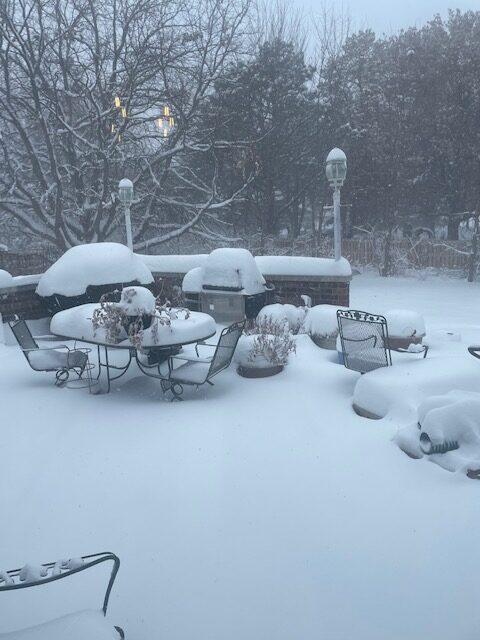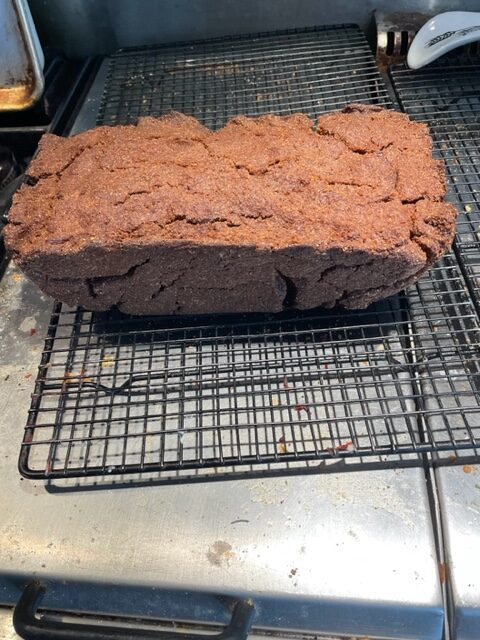Home › Forums › Baking — Breads and Rolls › What are you Baking the Week of February 12, 2023?
- This topic has 35 replies, 5 voices, and was last updated 1 year, 2 months ago by
Mike Nolan.
-
AuthorPosts
-
February 15, 2023 at 11:08 pm #38450
It's going to be a long wait to find out just how good it is. It probably wouldn't take well to being mailed, though.
February 16, 2023 at 9:29 am #38451This morning the aroma has more rye tones to it, but also a sweetness, I'm really hoping this loaf comes out as good as it smells. 3 more hours in the oven, and then waiting for it to cool and age for 2 days.
The weather bureau finally got one right, we've got a good 9 inches of snow on the back patio already, and it looks like we could get several more
We're staying home today.
Earlier I was looking at the bird feeder on a pole in the back yard, which we filled the other day. There was one rather large bird on it, probably the young Cooper's hawk we've seen several times. It sat there for several minutes, then flew off, and there have been a half-dozen or more birds at that feeder since, but they weren't getting close to that hawk!
Attachments:
You must be logged in to view attached files.February 16, 2023 at 11:19 am #38454The complexity of the aromas from the Westphalian pumpernickel bread continues to evolve as it gets close to the final hour in the oven.
The dominant odor at the moment is one I'd associate with molasses.
February 16, 2023 at 6:03 pm #38456Wow to all that snow, no we don't want that but it sure is pretty to look at from inside!
February 16, 2023 at 6:17 pm #38457I'd love to have a foot of snow dumped on my deck! All we have is brown grass. And it's been so warm (50s during the day) this week that it is now mud season here.
Today I made heart-shaped chocolate Linzer cookies with F.R.O.G. jam. That is an Amish jam made of figs, raspberries, orange peel and ginger. These were my belated valentine gift to my husband.
February 16, 2023 at 6:30 pm #38459The Westphalian pumpernickel bread has some big cracks in it, my guess is I didn't pack it tightly enough into the pan, it was pretty stiff. I've wrapped it in plastic and will let it age until Saturday afternoon. It is solid but it has a little give, so I don't think it's an inedible brick, but I'm worried it'll crumble when I try to cut it due to the cracks.
It smelled good coming out of the oven.
February 16, 2023 at 6:35 pm #38460Looks like we wound up with close to 10 inches of snow, it is already compressing a bit due to the afternoon sun, I went down to the mailbox and the surface was crunchy.
February 16, 2023 at 9:31 pm #38463That jam sounds delicious, Chocomouse!
Our weather has been unseasonably warm. We got rain today, and it is snowing lightly outside late this evening.
February 17, 2023 at 5:39 am #38464That is a lot for a loaf of bread. I'd like to see how bakeries make it in production.
In baker's math, how do I scale starter? I want to build out my spreadsheet for my starter bread. I mix starter, flour, and water and then mix that into my flour, water, and salt.
Thanks
February 17, 2023 at 10:04 am #38465In a two-stage bread, the starter is one column and the final dough is a second column, there's a third 'total' column as well.
If you refresh your starter like this: 500 grams of starter, 500 grams of flour, 500 grams of water, then in the starter column the flour is 100%, the water is 100% and the total yield for that stage is the amount you would add to the final dough, for example, 120 grams of starter. You'll have to weight it at least once, I guess, since a lot of recipes say to use something like a cup of starter, and the weight of that would vary based on the hydration level of the starter. 'Starter' becomes a row in the table and the amount you add is in the final recipe column.
This tells you that the starter is fed at a 100% hydration level (a common way of feeding a starter). How much starter you use when feeding it is a separate matter, it isn't clear to me exactly how that affects the starter over time. In the Tartine Bread books, Chad Robertson recommends using a very small amount of starter, like 1%, when feeding it, so he'd use 1 gram of starter to 100 grams of flour and 100 grams of water. He calls this an 'immature' starter.
I was recently reading a journal article in which the hydration level of the starter was one of the keys to the microculture the starter develops, higher hydration starters favor a different mix of yeasts and bacteria than lower hydration starters. How often you feed it, what you feed it and what temperature you keep it at are the other components, the article suggested that no matter how you get your starter going (build one, buy one, get one from a friend), those four factors (feeding frequency, hydration, flour, temperature) determine the microculture of the starter over time.
For example, one of the main LABs in sourdough is Fructilactobacillus sanfranciscensis (new nomenclature, lactobacillus was split up into several genuses, with fructilactobacillus being one of them) and in a starter kept at room temperature, fed at least daily, and at 100% or more hydration F. sanfranciscensis will become the dominant LAB, no matter where you live.
I've seen some recipes that have as many as five stages. The intermediate stages, like a starter, soaker, scald or mash, generally get added to the final dough stage, but not always, there's a really complex rye recipe where the stage 1 starter gets added to stage 2, along with other ingredients, then that stage gets added to stage 3, along with more ingredients, then that stage finally gets added to the final dough stage.
The BBGA formatting standard has a place for total % of prefermented flour, I'm not sure what that's used for, but is one of the factors you can manipulate, producing a bread with a different percentage of prefermented flour in it.
I'm playing around with a tool that would allow you to enter your ingredients and the baker's percentage of each (and total yield for each stage) and build an Excel spreadsheet for that recipe so you can adjust the total yield for the recipe and have it recompute each component. (I have plans to go well beyond just a simple spreadsheet generator, but one step at a time!)
February 17, 2023 at 10:15 am #38466I was wondering about how commercial bakeries produce Westphalian rye bread, my wife thinks in volume it might be easier than in small quantities, since commercial mixers are designed to handle stiff doughs better than most home mixers.
The ingredient list is simple enough: 750 grams of coarse rye meal, 750 grams of boiling water for the scald (though I added water, and could probably have added more, I think my rye was more finely ground than a 'coarse meal', and that soaked up a lot of water), another 350 grams of rye meal and 12 grams of salt in the final dough. No yeast. In fact, the scald probably kills off any yeast present in the rye, so what happens during the overnight rest for the scald is amylase activity to break down starch, not yeast activity.
February 17, 2023 at 6:07 pm #38467I forgot to post a picture of the Westphalian pumpernickel loaf as it came out of the pan. We're both looking forward to trying some tomorrow afternoon, probably with some sharp cheese.
Attachments:
You must be logged in to view attached files.February 17, 2023 at 9:07 pm #38471Very interesting project, Mike. I wonder if this is like some of the wrapped imported rye breads that we sometimes see at the stores?
I bought Dorie Greenspan's book, Dorie's Cookies, shortly after it came out in 2016. We were in the midst of preparing to move, once we did, we started the house renovation bog down, and then I had a diagnosis of high cholesterol. Almost every recipe in the book relies heavily on butter, so the book has sat unused. However, I was paging through it late last year and found a recipe for "Chocolate Chip Not-Quite Mandelbrot" (104-107) that uses oil rather than butter. While the cup of mini-chocolate chips are little fat bombs, the recipe makes 72 cookies, so I decided to bake it on Friday night. I made just one change by substituting half white whole wheat flour.
The dough was much easier to work with than I had feared. I did use my hand mixer to combine the eggs and sugar, then the oil and vanilla, but I combined the flour mixture and chips with it by hand. They were easy to slice after ten minutes of cooling. I used my offset knife. These go back in the oven with a cut side down and are sprinkled with additional cinnamon sugar. I used the Penzey's cinnamon sugar blend which includes vanilla. The cookies are not the traditional Mandelbrot as they have no almonds and are cakey rather than hard and dry. I ate some crumbs left from cutting them before the first bake and liked the taste.. I look forward to having them with some tea or coffee tomorrow.
February 17, 2023 at 9:27 pm #38473I made a batch of peanut butter cookies I got 27 cookies this time, my husband had some and said they were good.
February 17, 2023 at 9:54 pm #38475When we were in Germany (nearly 17 years ago) I had some really dark rye bread that I think may have been similar to a Westphalian pumpernickel.
Yes, I think it has some similarity to the wrapped rye breads. And unlike a lot of recipes, it doesn't rely on coffee, cocoa or food coloring to make it dark.
This first loaf mighty wind up being difficult to slice, but I'm hoping the flavor makes up for any slicing issues, and if there's a next time I'll probably add even more water than I did this time.
-
AuthorPosts
- You must be logged in to reply to this topic.

